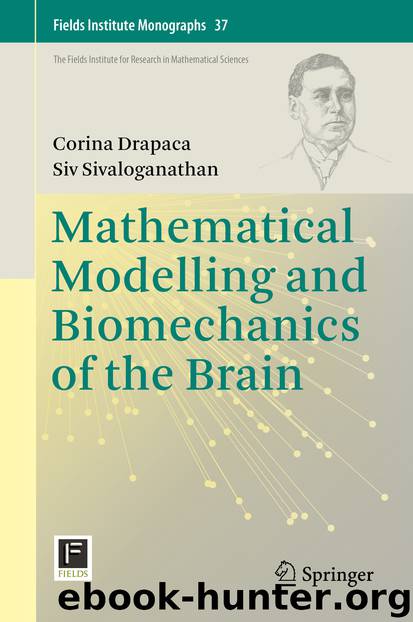Mathematical Modelling and Biomechanics of the Brain by Corina Drapaca & Siv Sivaloganathan

Author:Corina Drapaca & Siv Sivaloganathan
Language: eng
Format: epub
ISBN: 9781493998104
Publisher: Springer New York
(4.9)
where the subscripts e and ve indicate the elastic mode and viscoelastic modes respectively, and the superscript d stands for a deviatoric tensor. For each viscoelastic mode i, the deformation gradient is decomposed as:
where is the deformation gradient of the elastic part, and is the deformation gradient of the viscous part. Then the following constitutive laws for the viscoelastic modes and elastic modes are introduced:
(4.10)
where I 1 and I 2 are the invariants of B, the left deformation Cauchy-Green tensor corresponding to the elastic mode, and is the left Cauchy-Green deformation tensor of the elastic part of the viscoelastic mode i. Lastly, the viscosity is given by the fourth expression of (4.6). We notice that the constitutive model for polyethylene melts proposed in [181] has been used by Bilston et al. [11] (formulas (4.4)–(4.6)) and by Hrapko et al. [82] (formulas (4.9)–(4.10)), hence there are some similarities between these two models. The parameters of the model were fitted to experimental data obtained from shear tests done on porcine brain tissue in vitro. The results showed that the model predicts the brain response well during loading and relaxation, but fails to reproduce the brain behavior observed during unloading and recovery. The model proposed in [82] has been compared to other models under various boundary conditions in [84, 177].
The above mentioned studies highlight the fact that it is not only the type of non-linearity that is important for the accurate prediction of TBI by numerical simulations but also that other factors such as tissue anisotropy, more details of the head anatomy, as well as the complex interactions between the various structures inside the head play an important role. For instance, in most models the CSF surrounding the brain parenchyma and the meningeal layers are modelled either as an elastic solid with a low shear modulus or as a sliding interface [70]. More relevant details about the skull-brain interface which should be incorporated in numerical simulations of TBI were provided by Feng et al. [55]. This study used magnetic resonance imaging and image registration of landmark points on the skull to measure the brain motion relative to the skull caused by mild frontal impact of the head of volunteers. It was found that for mild events the relative brain displacements measured with respect to the skull were about 2–3 mm, with maximal principal strains of approximately 5%. Some authors [61, 62, 83] pointed out that the large variation among the viscoelastic properties of brain tissue existing in the literature on TBI could be caused by temperature effects, anisotropy, pre-compression, post-mortem time and sample preparation. Unifying and collating experimental data is important in order to test and validate the robustness and accuracy of numerical simulations of TBI. General criteria for data reconciliation have been proposed by researchers in the field. For instance, mechanical tests of brain tissue are temperature dependent and should be scaled by a horizontal shift factor [83]. The anisotropy of brain tissue is the underlying reason for differences observed in mechanical tests done on various planes.
Download
This site does not store any files on its server. We only index and link to content provided by other sites. Please contact the content providers to delete copyright contents if any and email us, we'll remove relevant links or contents immediately.
| AI & Machine Learning | Bioinformatics |
| Computer Simulation | Cybernetics |
| Human-Computer Interaction | Information Theory |
| Robotics | Systems Analysis & Design |
Algorithms of the Intelligent Web by Haralambos Marmanis;Dmitry Babenko(7878)
Hadoop in Practice by Alex Holmes(5671)
Jquery UI in Action : Master the concepts Of Jquery UI: A Step By Step Approach by ANMOL GOYAL(5527)
Life 3.0: Being Human in the Age of Artificial Intelligence by Tegmark Max(4534)
Functional Programming in JavaScript by Mantyla Dan(3732)
The Age of Surveillance Capitalism by Shoshana Zuboff(3441)
Big Data Analysis with Python by Ivan Marin(3159)
Blockchain Basics by Daniel Drescher(2906)
The Rosie Effect by Graeme Simsion(2729)
Test-Driven Development with Java by Alan Mellor(2688)
WordPress Plugin Development Cookbook by Yannick Lefebvre(2645)
Hands-On Machine Learning for Algorithmic Trading by Stefan Jansen(2563)
Data Augmentation with Python by Duc Haba(2541)
Applied Predictive Modeling by Max Kuhn & Kjell Johnson(2499)
Dawn of the New Everything by Jaron Lanier(2448)
Principles of Data Fabric by Sonia Mezzetta(2350)
The Infinite Retina by Robert Scoble Irena Cronin(2341)
The Art Of Deception by Kevin Mitnick(2311)
Rapid Viz: A New Method for the Rapid Visualization of Ideas by Kurt Hanks & Larry Belliston(2211)
